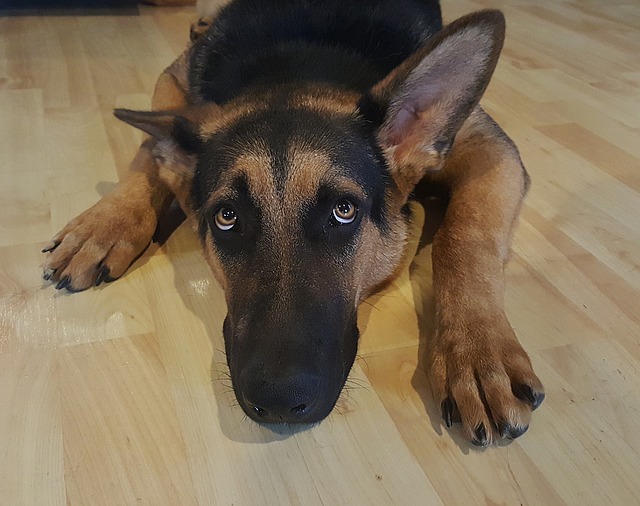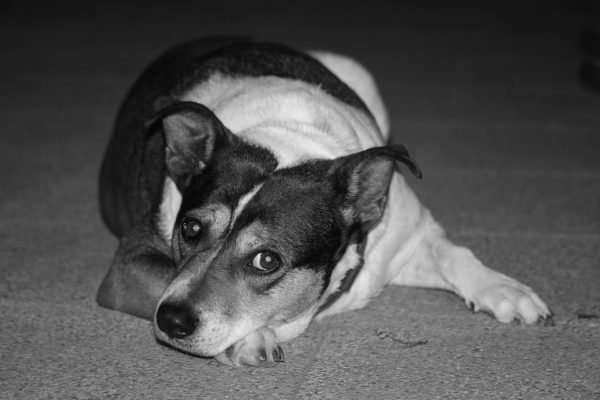Lots of dogs are afraid of thunder. We are fairly sure that the sound is what triggers the fear for most dogs, but some believe that barometric pressure and other features associated with storms may also elicit fear. A dog has learned that storms are unpleasant and for certain dogs, the tendency to develop phobias is already present.
Fear is a natural response to a threatening situation and thunder can seem threatening to many dogs. Fear becomes classified as anxiety when it becomes maladaptive (damages the life quality for the sufferer). Some dogs learn that storms are scary and it becomes a self-fulfilling prophecy- the dog thinks it is going to storm and starts to become afraid. The fear itself is uncomfortable and further adds to the anticipation of the storm. It is a vicious cycle. It is like the dog is afraid of the storm,which would be wise if he lived out in the wild, but then he fears being afraid and it just keeps spiraling down.

Certain chemicals in the brain have been linked to maladaptive anxiety for many species, including dogs and humans. The hormone, cortisol has been associated with feelings of stress. The cortisol levels in blood and saliva are measurable in a lab setting to help understand the pathology of stress.1 It is harder to define anxiety for our dogs because dogs cannot answer questions about their feelings, but most dog lovers who have experienced thunderstorm anxiety are well aware of its effects.
Dogs that are experiencing thunderstorm anxiety will sometimes vocalize, eliminate, salivate, tremble and/or hide. The signs can escalate to the point where the dog risks injuring himself. There are some things that you can do to help if you think that your dog has a thunderstorm phobia.
A Safe House
Give your dog somewhere to go that is protected and safe, like a covered crate or a basement that insulates him/her from the sights and sounds of the storm. You might choose to play music or white noise to stop the spiral of sounds causing fear and fear of fear taking hold. Don’t force your dog into the “safe place” because then it may not seem safe at all. Be aware that some animals become more frightened if they are confined, so he/she should be able to choose whether or not to stay there.
The chance to make good choices
Give your dog an opportunity to put his brain on the right road. Ask him to sit and stay and do other tricks that he knows. (You might need to practice ahead of time) Promptly reward him with a high value treat. If his brain pathways switch from fear leading to more fear, and onto doing things that get positive reinforcement, then it is a much better situation for him. Meanwhile, ignore anxious behavior and stay on track. If you console and cajole the fear, he may believe that you are also afraid and it will not help.

Other things to try
Some dogs respond well to the addition of tight fitting garments, like when you swaddle a baby. Studies suggest that the tightness helps balance out brain chemistry and resists the formation of the negative ones. There are many brands that you can try or you can fashion one from some of your old t shirts, etc. Some people swear by desensitization during calm times. You can teach the dog that the sound is an everyday non-fearful stimulus with a music track of a storm. Start with the volume low and increase it over several months. Because it is only the sound and not the other frightening features, it might not be as effective as you would hope, but is worth a shot.
Get Help
Your veterinarian is an excellent resource to help you desensitize your dog from the phobia. There are medications and behavior modification programs to try. There isn’t a quick fix no matter what, but with your veterinarian’s help, you and your dog can weather the storms!
From the Editor: Canine anxiety is a real and significant problem for many dogs, whether from thunder, fireworks, or separation. We worked with a veterinarian to formulate our all natural calming hemp chews for dogs. Give them a try, they’re 100% drug free!
- J Vet Sci. 2015 Dec 8. [Epub ahead of print]Evaluation of effects of olfactory and auditory stimulation on separation anxiety by salivary cortisol measurement in dogs. Shin YJ, Shin NS.

 Toledo, United States.
Toledo, United States.